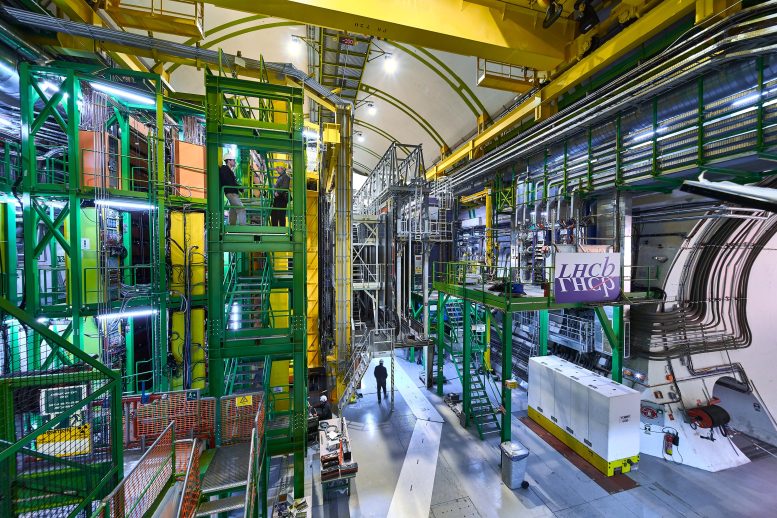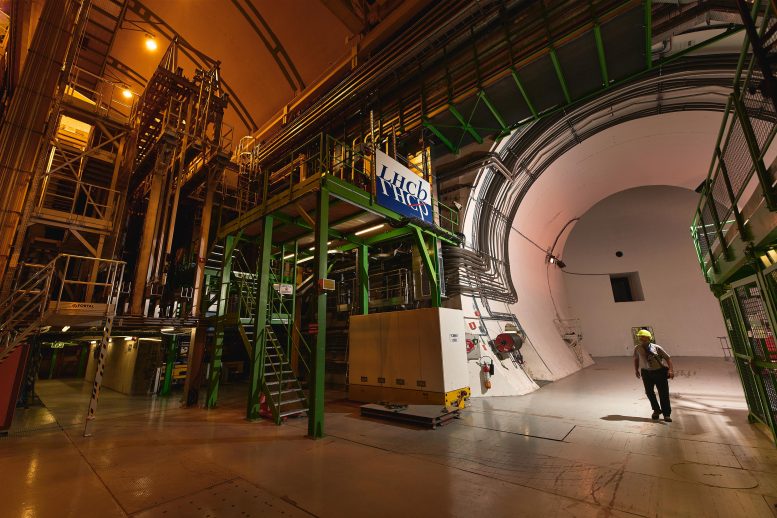
Recently at the Quark Matter conference and before that at the Rencontres de Moriond conference, the Large Hadron Collider beauty (LHCb) collaboration presented an analysis of particle collisions at the Large Hadron Collider (LHC) that may help determine whether or not any antimatter seen by experiments in space originates from the dark matter that holds galaxies such as the Milky Way together.
Space-based experiments such as the Alpha Magnetic Spectrometer (AMS), which was assembled at CERN and is installed on the International Space Station (ISS), have detected the fraction of antiprotons, the antimatter counterparts of protons, in high-energy particles called cosmic rays. These antiprotons could be formed when dark-matter particles collide with each other, but they could also be created in other instances, such as when protons collide with atomic nuclei in the interstellar medium, which is primarily composed of hydrogen and helium.
LHCb reveals secret of antimatter creation in cosmic collisions. The finding may help find out whether or not any antimatter seen by experiments in space originates from dark matter. Credit: CERN
To find out whether or not any of these antiprotons originate from dark matter, physicists therefore have to estimate how often antiprotons are produced in collisions between protons and hydrogen as well as between protons and helium. While some measurements of the first have been made, and LHCb reported in 2017 the first-ever measurement of the second, that LHCb measurement involved only prompt antiproton production – that is, antiprotons produced right at the place where the collisions took place.

In their new study, the LHCb physicists also looked for antiprotons produced at some distance from the collision point, through the transformation, or “decay,” of particles called antihyperons into antiprotons. To make this new measurement and the previous one, the LHCb scientists, who usually use data from proton–proton collisions for their investigations, instead used data from proton–helium collisions obtained by injecting helium gas into the point where the two LHC proton beams would normally collide.
By analyzing a sample of some 34 million proton–helium collisions and measuring the ratio of the production rate of antiprotons from antihyperon decays to that of prompt antiprotons, the LHCb researchers found that, at the collision energy scale of their measurement, the antiprotons produced via antihyperon decays contribute much more to the total antiproton production rate than the amount predicted by most models of antiproton production in proton–nucleus collisions.

“This result complements our previous measurement of prompt antiproton production, and it will improve the predictions of the models,” says LHCb spokesperson Chris Parkes. “This improvement may in turn help space-based experiments find evidence of dark matter.”
“Our technique of injecting gas into the LHCb collision point was originally conceived to measure the size of the proton beams,” says LHCb physics coordinator Niels Tuning. “It is really nice to see again that it also improves our knowledge of how often antimatter should be created in cosmic collisions between protons and atomic nuclei.”
1 Comment
IMHO, Dark Matter is just a side-effect caused by Dark Energy (which is the real mystery)!
As an analogy, consider growing/inflating pockets of gas in rising dough!
(Imagine spacetime as a bubbling/boiling (because of incoming DE!) superfluid!)
(So the locations in space w/ “lots of DM” are actually just where spacetime superfluid is denser!)
As for evidence:
Isn’t it true that geometric structure of Cosmic Web looks really like bubbling (instead of collapsing!)? (So it has positive curvature instead of negative!?)
Isn’t it true that some galaxies appear to have too much DM & so others too little (contrary to all expectations!)?
(& not to mention, no experiment/observation is ever able to find any new particle which could be what DM is made of!)